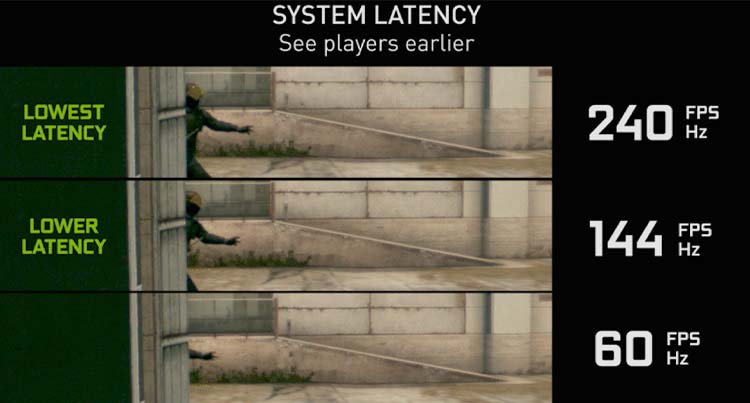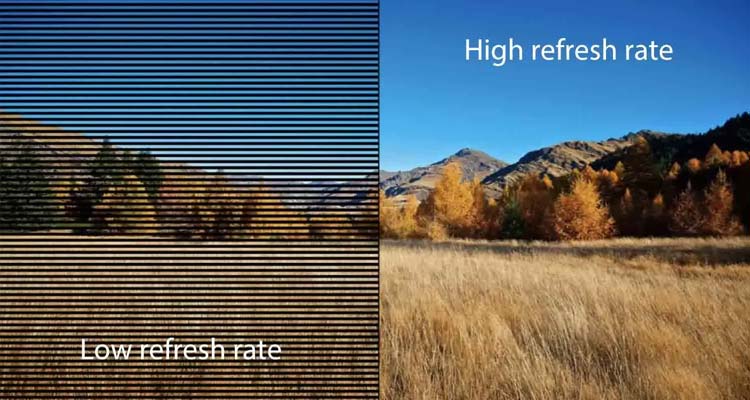The concept of refresh rate exists in all electronic devices, and LED displays are no exception. A higher refresh rate means a better viewing and operating experience, so many high-end gamers or professional audio/video producers will prioritize higher resolution screens.
Our common refresh rates are 60Hz, 120Hz, 140Hz and 240Hz, but the refresh rate of LED displays will be different from other screens, it is usually 1920Hz, 3840Hz and 7680Hz, let’s continue to understand.
What is refresh rate?
Refresh rate is actually the number of times a monitor refreshes the screen per second in Hertz (Hz). This means that a 60Hz monitor can refresh 60 frames per second, 144Hz refreshes 144 frames, and so on.

What is the LED display refresh rate?
Unlike a monitor, the refresh rate of an LED display is calculated differently, so the value seems much larger. The refresh rate of an LED display is the number of times the LED lights come on and go off in a minute. For example, the number of times the LED lights are on and off in one minute is 57,600 times, and the value obtained after dividing it by 60 seconds is 960Hz, which means that the refresh rate of this LED display is 960Hz.

Refresh rate as one of our selection of LED display quality standards, common LED display refresh rate of 1920Hz, 3840Hz and 7680Hz. 960Hz LED display is the earlier use of the screen, due to its poor display effect, the screen jitter is serious, has been basically eliminated.
What are the similarities and differences between the two?
Similarities
Whether it is the resolution or the resolution of the LED display, the essence is to measure the fineness of the image, higher resolution can make the image more clear and detailed. At the same time, higher resolution can also bring better visual experience and reduce the occurrence of image jitter, tearing, flickering and other problems.
Differences
We can see from the definitions of the two that they do not mean the same thing. From a technical point of view, the resolution of a monitor is calculated in terms of the performance of the GPU (image processor), while the resolution of an LED display is calculated in terms of the flickering speed of the LED beads.
Comparison of 1920Hz, 3840Hz and 7680Hz
Alias
Similar to the resolution of video, for example, 720P is called HD and 1080P is called FHD, the resolution of LED display also has corresponding names, 1920Hz is called normal refresh rate, 3840Hz is called high refresh rate, and 7680Hz is called ultra-high refresh rate.
Display effect
In fact, from the naked eye, regardless of 1920Hz, 3840Hz, or 7680Hz, will not see a significant difference. However, if the application scene for the stadium, stages, etc. need to shoot or live, we must choose a higher refresh rate of the LED display in order to avoid the problem of water ripples in the screen, otherwise it will affect the audience to watch the screen effect.

Visual fatigue
Low refresh rate LED display will appear screen jitter and flicker and other problems, these problems will make our eyes more easily fatigued. If we need to watch the screen for a long time, then there is no doubt that choosing a screen with a higher refresh rate is the best.
Price
The higher the refresh rate, the better the quality of IC and chips used in the LED display, but the price will be much higher. We must compare each parameter carefully when choosing LED display.
Application Scene
If it is only some daily use scenes, such as supermarkets, retail stores, etc., and the requirements for shooting and live broadcasting are low, you can choose 1920Hz LED display. If it is like concerts, stadiums and other scenes with high requirements for shooting and live broadcasting, it is recommended to choose 3840Hz or 7680Hz, to avoid affecting the shooting effect because of moire. If it is used for virtual shooting, this kind of high-speed camera on the picture of the fineness requirements are very high, usually need to choose 7680Hz this kind of ultra-high refresh rate.
Can LED screen resolution be increased?
Some customers have asked, “If I choose 1920Hz before, can I upgrade to 3940Hz later?” . The answer is no. The resolution of the LED screen is realized by the driver IC, not by software or material, which has been fixed when the LED display is shipped from the factory, and can not be improved by human beings at a later stage.
LED screen resolution the higher the better?
There is no doubt that the resolution of LED screen is definitely the higher the better. This is like we choose a different aspect ratio of the screen, if the price difference is not much will give priority to the higher resolution of the screen.
However, we have to recognize the fact that, that is, the higher the resolution of the LED display screen price is also higher, the LED display itself is expensive, if only general use of the scene, choose a lower refresh rate of the LED display can help us save a lot of money.
Summary of this article
This article describes in detail the LED screen resolution of the relevant content, and readers are more concerned about “whether the resolution can be increased” and “whether the higher the better the resolution” to do a detailed answer, I believe it can help you solve your doubts.




